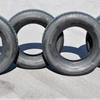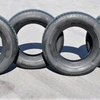Answer
Jun 03, 2024 - 09:47 AM
R (Radial) Trailer Tires:Construction: Radial tires have cords that run at a 90-degree angle to the direction of travel, with belts running beneath the tread. This design allows the tire sidewall and the tread to function independently.Advantages: Radial tires generally offer better heat dissipation, a smoother ride, and longer tread life. They also provide improved traction and fuel efficiency.Use: Ideal for long-distance towing and highway use.D (Bias Ply) Trailer Tires:Construction: Bias ply tires have cords that run at a 30-45 degree angle to the direction of travel, with layers of ply crisscrossing over each other. This design causes the entire tire to flex as a single unit.Advantages: Bias ply tires typically have stiffer sidewalls, which can enhance stability and handling under heavy loads. They are often more durable in off-road conditions and are generally less expensive than radial tires.Use: Suitable for shorter trips, off-road conditions, and heavy-duty applications where sidewall strength is crucial.Choosing between radial and bias ply tires depends on your specific needs, including the type of terrain, distance of travel, and load requirements.



